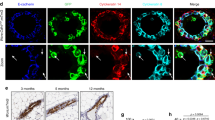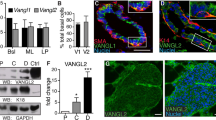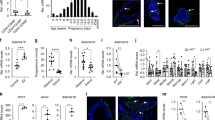Abstract
The mammary gland epithelium comprises two major cell types: basal and luminal. Basal cells interact directly with the extracellular matrix (ECM) and express higher levels of the ECM receptors, integrins, than luminal cells. We show that deletion of β1 integrin from basal cells abolishes the regenerative potential of the mammary epithelium and affects mammary gland development. The mutant epithelium was characterized by an abnormal ductal branching pattern and aberrant morphogenesis in pregnancy, although at the end of gestation, the secretory alveoli developed from β1 integrin-positive progenitors. Lack of β1 integrin altered the orientation of the basal-cell division axis and in mutant epithelium, in contrast to control tissue, the progeny of β1 integrin-null basal cells, identified by a genetic marker, was found in the luminal compartment. These results reveal, for the first time, the essential role of the basal mammary epithelial cell–ECM interactions mediated by β1 integrins in the maintenance of a functional stem cell population, mammary morphogenesis and segregation of the two major mammary cell lineages.
This is a preview of subscription content, access via your institution
Access options
Subscribe to this journal
Receive 12 print issues and online access
$209.00 per year
only $17.42 per issue
Buy this article
- Purchase on Springer Link
- Instant access to full article PDF
Prices may be subject to local taxes which are calculated during checkout





Similar content being viewed by others
References
Hennighausen, L. & Robinson, G. W. Information networks in the mammary gland. Nature Rev. Mol. Cell Biol. 6, 715–725 (2005).
Visvader, J. E. & Lindeman, G. J. Mammary stem cells and mammopoiesis. Cancer Res. 66, 9798–9801 (2006).
Smalley, M. & Ashworth, A. Stem cells and breast cancer: A field in transit. Nature Rev. Cancer 3, 832–844 (2003).
Shackleton, M. et al. Generation of a functional mammary gland from a single stem cell. Nature 439, 84–88 (2006).
Stingl, J et al. Purification and unique properties of mammary epithelial stem cells. Nature 439, 993–997 (2006).
Asselin-Labat, M. L. et al. Steroid hormone receptor status of mouse mammary stem cells. J. Natl Cancer Inst. 98, 1011–1014 (2006).
Deugnier, M. A. et al. EGF controls the in vivo developmental potential of a mammary epithelial cell line possessing progenitor properties. J. Cell Biol. 159, 453–463 (2002).
Deugnier, M. A. et al. Isolation of mouse mammary epithelial progenitor cells with basal characteristics from the Comma-Dβ cell line. Dev. Biol. 293, 414–425 (2006).
Faraldo, M. M., Deugnier, M. A., Lukashev, M., Thiery, J. P. & Glukhova, M. A. Perturbation of β1-integrin function alters the development of murine mammary gland. EMBO J. 17, 2139–2147 (1998).
White, D. E. et al. Targeted disruption of β1-integrin in a transgenic mouse model of human breast cancer reveals an essential role in mammary tumor induction. Cancer Cell 6, 159–170 (2004).
Li, N. et al. β1 integrins regulate mammary gland proliferation and maintain the integrity of mammary alveoli. EMBO J. 24, 1942–1953 (2005).
Naylor, M. J. et al. Ablation of β1 integrin in mammary epithelium reveals a key role for integrin in glandular morphogenesis and differentiation. J. Cell Biol. 171, 717–728 (2005).
Sleeman, K. E. et al. Dissociation of estrogen receptor expression and in vivo stem cell activity in the mammary gland. J. Cell Biol. 176, 19–26 (2007).
Gusterson, B. A., Ross, D. T., Heath, V. J. & Stein, T. Basal cytokeratins and their relationship to the cellular origin and functional classification of breast cancer. Breast Cancer Res. 7, 143–148 (2005).
Ramirez, A. et al. A keratin K5Cre transgenic line appropriate for tissue-specific or generalized Cre-mediated recombination. Genesis 39, 52–57 (2004).
Teuliere, J. et al. Targeted activation of β-catenin signaling in basal mammary epithelial cells affects mammary development and leads to hyperplasia. Development 132, 267–277 (2005).
Brakebusch, C. et al. Skin and hair follicle integrity is crucially dependent on β1 integrin expression on keratinocytes. EMBO J. 19, 3990–4003 (2000).
Lechler, T. & Fuchs, E. Asymmetric cell divisions promote stratification and differentiation of mammalian skin. Nature 437, 275–280 (2005).
Reverte, C. G., Benware, A., Jones, C. W. & LaFlamme, S. E. Perturbing integrin function inhibits microtubule growth from centrosomes, spindle assembly, and cytokinesis. J. Cell Biol. 174, 491–497 (2006).
Fernández-Miñán, A., Martín-Bermudo, M. D. & González-Reyes, A. Integrin signaling regulates spindle orientation in Drosophila to preserve the follicular-epithelium monolayer. Curr. Biol. 17, 683–688 (2007).
Kouros-Mehr, H., Slorach, E. M., Sternlicht, M. D. & Werb, Z. GATA-3 maintains the differentiation of the luminal cell fate in the mammary gland. Cell 127, 1041–1055 (2006).
Asselin-Labat, M. L. et al. Gata-3 is an essential regulator of mammary-gland morphogenesis and luminal-cell differentiation. Nature Cell Biol. 9, 201–209 (2007).
Wagner, K. U. et al. An adjunct mammary epithelial cell population in parous females: its role in functional adaptation and tissue renewal. Development 129, 1377–1386 (2002).
Matulka, L. A., Triplett, A. A. & Wagner, K. U. Parity-induced mammary epithelial cells are multipotent and express cell surface markers associated with stem cells. Dev. Biol. 303, 29–44 (2007).
Gibson, M. C. & Perrimon, N. Apicobasal polarization: epithelial form and function. Curr. Opin. Cell Biol. 15, 747–752 (2003).
Bissell, M. J., Rizki, A. & Mian, I. S. Tissue architecture: the ultimate regulator of breast epithelial function. Curr. Opin. Cell Biol. 15, 753–762 (2003).
Tanentzapf, G., Devenport, D., Godt, D. & Brown, N. H. Integrin-dependent anchoring of a stem-cell niche Nature Cell Biol. 9, 1413–1418 (2007).
Potocnik, A. J., Brakebusch, C. & Fassler, R. Fetal and adult hematopoietic stem cells require β1 integrin function for colonizing fetal liver, spleen, and bone marrow. Immunity 12, 653–663 (2000).
Deome, K. B., Faulkin, Jr., L. J., Bern, H. A. & Blair, P. B. Development of mammary tumors from hyperplastic alveolar nodules transplanted into gland-free mammary fat pads of female C3H mice. Cancer Res. 19, 515–520 (1959).
Acknowledgements
We are particularly grateful to I. Grandjean, and the personnel of the animal facilities at Institut Curie for taking care of the mice, and to Z. Maciorowski and A. Viguier for assistance with FACS analyses. We would also like to thank J. L. Jorcano for providing the K5-cre mice, M. Bissell, C. Brakebusch and M. Moumen for valuable discussions, A.-M. Valles for comments on the manuscript and M. Denoyelle for technical assistance. This work was supported by the Association pour la Recherche contre le Cancer (ARC 3295 and 3771) and La Ligue Nationale Contre le Cancer (Equipe Labelisée 2006). I.T. was supported by a grant from Fondation pour la Recherche Médicale (FRM). M.M.F. and M.A.D. are Chargés de Recherche, and M.A.G. is Directeur de Recherche at the Institut National de la Santé et de la Recherche Médicale (INSERM).
Author information
Authors and Affiliations
Corresponding author
Ethics declarations
Competing interests
The authors declare no competing financial interests.
Supplementary information
Supplementary Information
Supplementary Figures S1, S2, S3, S4, S5, Supplementary Table S1 and Supplementary Data (PDF 992 kb)
Rights and permissions
About this article
Cite this article
Taddei, I., Deugnier, MA., Faraldo, M. et al. β1 Integrin deletion from the basal compartment of the mammary epithelium affects stem cells. Nat Cell Biol 10, 716–722 (2008). https://doi.org/10.1038/ncb1734
Received:
Accepted:
Published:
Issue Date:
DOI: https://doi.org/10.1038/ncb1734
This article is cited by
-
Annexin A1 is a polarity cue that directs mitotic spindle orientation during mammalian epithelial morphogenesis
Nature Communications (2023)
-
Distinct Requirements for Adaptor Proteins NCK1 and NCK2 in Mammary Gland Development
Journal of Mammary Gland Biology and Neoplasia (2023)
-
Integrating single-cell RNA-sequencing and functional assays to decipher mammary cell states and lineage hierarchies
npj Breast Cancer (2020)
-
TRAF6 maintains mammary stem cells and promotes pregnancy-induced mammary epithelial cell expansion
Communications Biology (2019)
-
Gap Junctions and Wnt Signaling in the Mammary Gland: a Cross-Talk?
Journal of Mammary Gland Biology and Neoplasia (2019)



